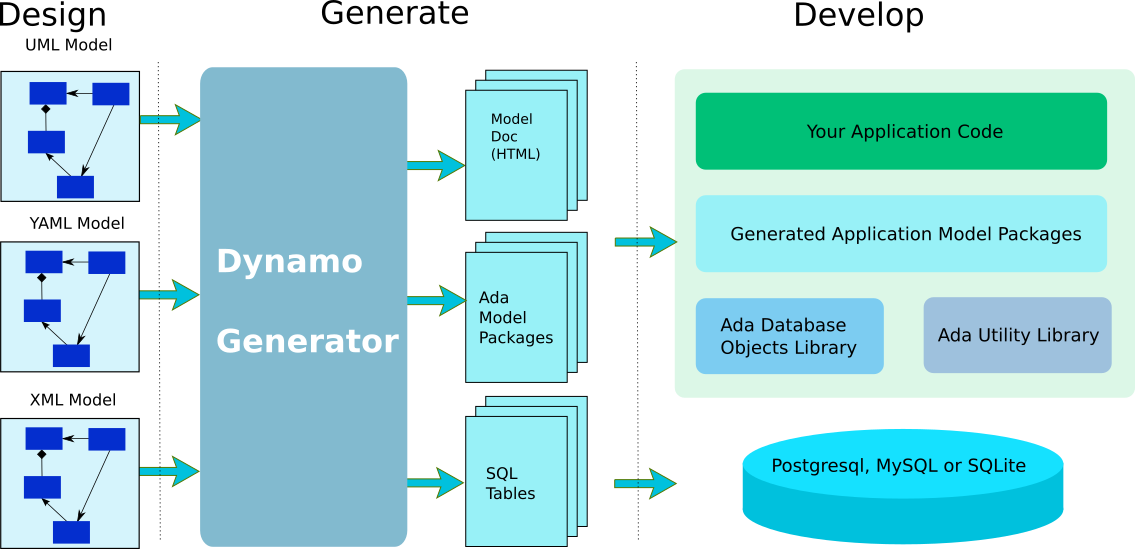Ada Database Objects is an Ada05 library that provides object relational mapping to access a database in Ada05. The library supports Postgresql, MySQL, SQLite as databases. Most of the concepts developped for ADO come from the Java Hibernate ORM.
The ORM uses an YAML, XML mapping file or an UML model, a code generator and a runtime library for the implementation. It provides a database driver for Postgresql, MySQL and SQLite. The ORM helps your application by providing a mapping of your database tables directly in the target programming language: Ada05 in our case. The development process is the following:
- You design your database model either using a UML tool or by writing a YAML or XML description,
- You generate the Ada05 mapping files by using the Dynamo code generator,
- You generate the SQL database tables by using the same tool,
- You write your application on top of the generated code that gives you direct and simplified access to your database.
You need at least one of these databases (or all of then). The configure script will now fail if no supported database was found. Check the Database Drivers section to install them and run the configure again after the installation.
- Cleanup build environment to drop configure
If you are using Alire in your project, run the following command within your Alire project to use the library:
alr with ado
Depending on your project, you may need one or some of the following other components to get the support for SQLite, MySQL or PostgreSQL:
alr with ado_sqlite
alr with ado_mysql
alr with ado_postgresql
If you don't have Alire or want to build and install the library
on a specific place, run a setup command to configure the build as well as installation
directory.
For a detailed description on how you can configure, build and install the library
refer to the Installation guide.
Otherwise, you can easily configure and build the library with the steps described below.
The support for SQLite, MySQL and PostgreSQL are enabled only when a HAVE_XXX=yes configuration
variable is defined. Run the setup command that records in the Makefile.conf the configuration
you want to build.
The HAVE_ALIRE configuration allows you to build with Alire or not.
The example below enables the SQLite and PostgreSQL components but disables the MySQL support and disables the use of Alire to build the library.
make setup BUILD=debug PREFIX=/build/install \
HAVE_SQLITE=yes HAVE_POSTGRESQL=yes \
HAVE_MYSQL=no HAVE_ALIRE=no
Then build, run the unit tests and install by using:
make
make test
make install
To use the installed libraries, make sure your ADA_PROJECT_PATH contains the directory
where you installed the libraries (configured by the PREFIX=<path> option in the setup phase).
The installed GNAT projects are the same as those used when using Alire.
The samples can be built using:
make samples
or
cd samples
alr build
Before launching the samples, the database must have been created. For SQLite, use:
make samples.db
The Ada Database Objects sources as well as a wiki documentation is provided on:
- Ada Database Objects Programmer's Guide PDF
- ADO Documentation
- ADO Sessions
- ADO Statements
- ADO Queries
- ADO Drivers
- Persistence with Ada Database Objects FOSDEM 2019
- Uses Ada Database Objects: Implementing a build manager in Ada
The Postgresql, MySQL and SQLite development headers and runtime are necessary for building the ADO driver. The configure script will use them to enable the ADO drivers.
Postgresql Development installation
sudo apt-get install postgresql-client libpq-dev
MySQL Development installation
sudo apt-get install mariadb-client libmariadb-dev
SQLite Development installation
sudo apt-get install sqlite3 libsqlite3-dev
For Windows, check win32/README to install the libraries.
Create the tests database by using the Dynamo command. (Dynamo is available at: https://gitlab.com/stcarrez/dynamo) Note: change 'root' and 'password' to a MySQL user that has admin access rights ('create database' and 'grant option' privileges).
dynamo create-database db/regtests root password
The default database connection string is defined in dynamo.xml. You can also specify the connection string and create the schema by using:
dynamo create-database db/regtests 'mysql://localhost:3306/ado_test?user=ado' root password
To create manually the database, you can proceed to the following steps:
- Create the 'ado_test' database in MySQL
sudo mysql
mysql> CREATE DATABASE ado_test;
- Create the 'ado' user and give the access rights:
mysql> CREATE USER 'ado' IDENTIFIED BY '';
mysql> GRANT SELECT, INSERT, UPDATE, DELETE,
CREATE, DROP, CREATE TEMPORARY TABLES, EXECUTE,
SHOW VIEW ON `ado_test`.* TO ado@'%';
mysql> FLUSH PRIVILEGES;
- Create the tables
mysql> USE ado_test
mysql> SOURCE db/regtests/mysql/create-ado-mysql.sql
To create manually the database, you can proceed to the following steps:
- Create the 'ado' user and configure the password (enter 'ado' for the password or update the Makefile as well as the test-postgresql.properties file):
sudo -u postgres createuser ado --pwprompt
- Create the 'ado_test' database in Postgresql
sudo -u postgres createdb -O ado ado_test
- Create the tables
psql "postgresql://localhost:5432/ado_test?user=ado&password=ado" \
--file=db/regtests/postgresql/create-ado-postgresql.sql
Before running the unit tests for MySQL or Postgresql, you must create the test database as described in Database Creation.
The unit tests are built and executed using:
make test
To run manually the unit tests, use the following commands:
bin/ado_harness -config test-mysql.properties
or
bin/ado_harness -config test-sqlite.properties
or
bin/ado_harness -config test-postgresql.properties
The ADO Programmer's Guide is generated by using Dynamo and Pandoc. You may need the following Debian packages:
sudo apt-get install pandoc xsltproc texlive-latex-base texlive-latex-extra texlive-fonts-extra
The documentation is created by the following command:
make doc
and the book is generated in the ado-book.pdf file.
